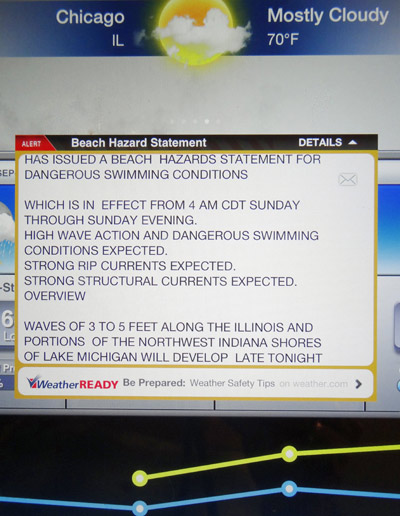Ohio Street Beach

Back to Ohio Street Beach
Back to Ohio Street Beach
Is it safe to swim?
For decades, swimming bans along Lake Michigan's shores were a major, and all too frequent, frustration for Chicago beach-goers. Beaches were closed when daily water samples showed unusually high levels of E. coli, a sign that the water is contaminated with other, more dangerous bacteria. These tests took time to analyze. By the time results were in, the sample was almost a day old. This delay meant beach-goers were kept out of the water even after it was safe to swim again.
The Chicago Park District has moved away from individual samples in favor of buoys and weather stations that transmit data in real time. The buoys measure things like water temperature, wave movement, and cloudiness, each of which has a hand in high E. coli levels. Officials use this information to predict when bacteria have contaminated the water. The city no longer bans swimming due to E. coli. Instead, they warn swimmers that they are taking a risk if they go for a dip.
Data on wave height and frequency are also used by the National Weather Service to warn boaters and beach goers about strong waves and dangerous currents. Each year, an average of roughly three to five people drown in Lake Michigan after getting caught in rip currents, making them a leading hazard for anyone spending a day at the lake. The data collected from buoys helps meteorologists anticipate where these hazardous currents will likely spring up and inform officials when swimmers should be kept out of the water.
The Chicago Park District has moved away from individual samples in favor of buoys and weather stations that transmit data in real time. The buoys measure things like water temperature, wave movement, and cloudiness, each of which has a hand in high E. coli levels. Officials use this information to predict when bacteria have contaminated the water. The city no longer bans swimming due to E. coli. Instead, they warn swimmers that they are taking a risk if they go for a dip.
Data on wave height and frequency are also used by the National Weather Service to warn boaters and beach goers about strong waves and dangerous currents. Each year, an average of roughly three to five people drown in Lake Michigan after getting caught in rip currents, making them a leading hazard for anyone spending a day at the lake. The data collected from buoys helps meteorologists anticipate where these hazardous currents will likely spring up and inform officials when swimmers should be kept out of the water.
